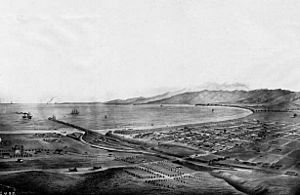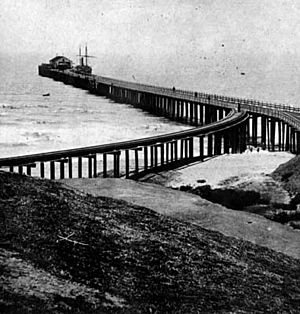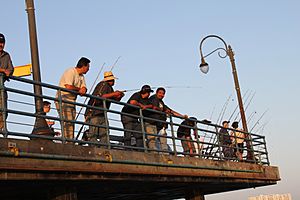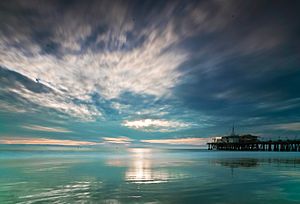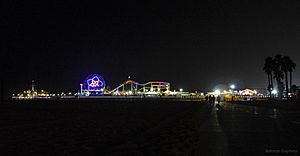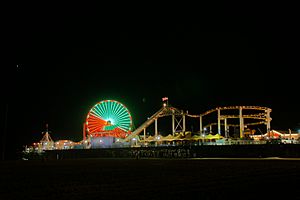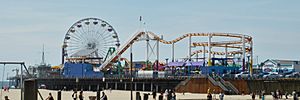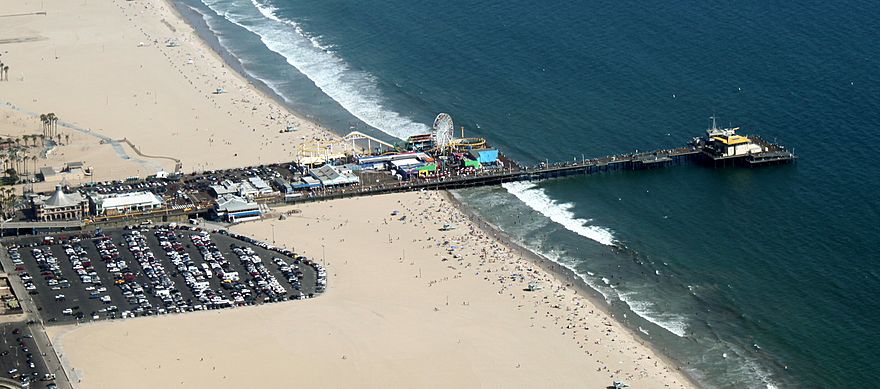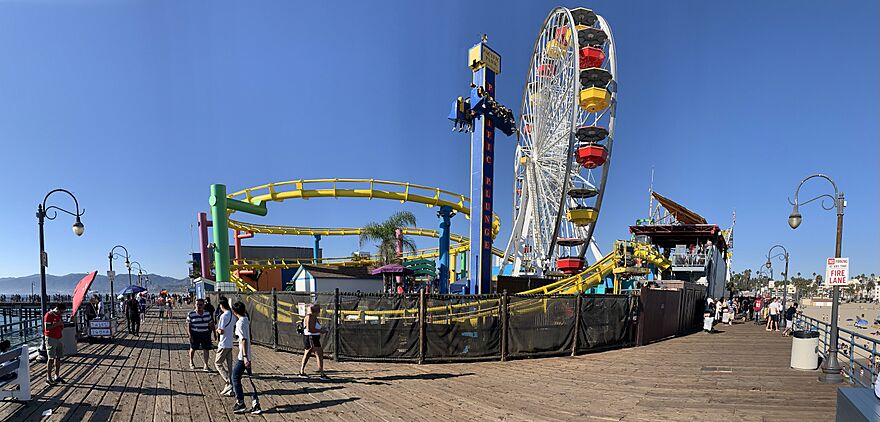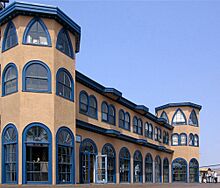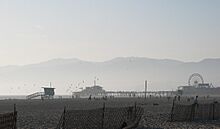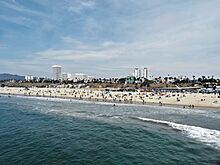Santa Monica Pier facts for kids
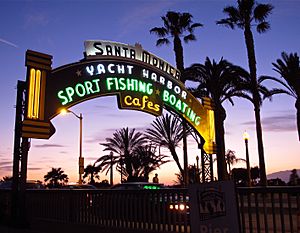
Landmark entrance to the Santa Monica Pier
|
|
| Type | Amusement Pier |
|---|---|
| Carries | Pedestrians |
| Spans | Pacific Ocean |
| Locale | Santa Monica, California, U.S. |
| Maintained by | Santa Monica Pier Corporation |
| Owner | Pacific Park |
| Total length | 1,651.5 feet (500 m) |
| Width | 301.2 feet (90 m) |
| Vertical clearance | 26 feet (10 m) |
| Opening date | September 9, 1909 |
| Coordinates | 34°00′31″N 118°29′55″W / 34.00861°N 118.49861°W |
| Designated | August 17, 1976 |
The Santa Monica Pier is a super fun place to visit in Santa Monica, California, in the United States! It's a big pier that stretches out into the Pacific Ocean. You can find a small amusement park there, yummy food stands, and awesome spots to look at the ocean or go fishing. The pier is also part of the larger Santa Monica Mountains National Recreation Area.
Contents
Fun Things to Do at Santa Monica Pier
Pacific Park: Rides and Games!
The pier is home to Pacific Park, a cool family amusement park. It has a special Ferris wheel that runs on solar panels! This brightly lit wheel can be seen from far away. Sometimes, it even turns off its lights for Earth Hour to help save energy.
More Awesome Attractions
There's so much more to explore! You can ride an old-fashioned carousel from the 1920s inside the Santa Monica Looff Hippodrome. There's also the Santa Monica Pier Aquarium, run by Heal the Bay, where you can learn about ocean animals. You'll find shops, street performers, a video arcade, and even a trapeze school! If you like to fish, the very end of the pier is a popular spot for anglers. The pier also hosts outdoor concerts, movies, and other exciting events.
A Look Back: History of the Pier
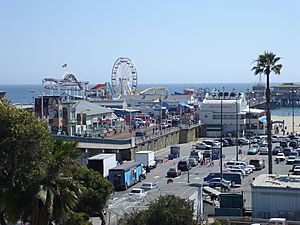
The Santa Monica Pier you see today is actually two piers that joined together! The first part, called the Municipal Pier, opened on September 9, 1909. It was mainly built to carry pipes out into the ocean. Later, in 1916, another pier called the Pleasure Pier was built by Charles I. D. Looff, who was famous for building amusement parks.
Early Fun on the Pleasure Pier
The Pleasure Pier quickly became a popular spot. It had the Santa Monica Looff Hippodrome building, which still houses the carousel today! There were also roller coasters, other rides, and funhouses. The beautiful carousel, built in 1922, has 44 hand-carved horses. It was rebuilt in 1990 and still plays music from a special instrument called a calliope.
The La Monica Ballroom
In 1924, a huge dance hall called the La Monica Ballroom opened. It was the biggest dance hall on the west coast! Thousands of people could dance there. Later, it even became a roller skating rink where speed skating champions practiced. Sadly, the ballroom was taken down in 1963.
Challenges and Comebacks
During the 1930s, many of the pier's attractions closed because of tough economic times. In 1938, a new bridge and entry gate were built for the pier. For a while, some people wanted to remove the pier entirely! But citizens formed a group to "Save Santa Monica Bay" and protect the pier. Their efforts worked, and the pier was saved in 1973. That same year, the carousel and Hippodrome were even used in the movie The Sting!
Storms and Rebuilding
In 1983, big storms hit the pier very hard. Parts of it were destroyed by huge waves. It was a tough time, but the city worked hard to repair it.
New Beginnings with Pacific Park
After all the repairs, the Santa Monica Pier welcomed Pacific Park in 1996. This was the first new amusement park on the pier since the 1930s, bringing back lots of fun and excitement!
Recent Events
In 2009, there was advice about eating fish caught near the pier due to certain levels of chemicals. In October 2023, there was an incident where a man climbed onto the Ferris wheel, leading to a temporary evacuation. He was later arrested.
Who Manages the Pier?
The City of Santa Monica created a special group called the Santa Monica Pier Corporation (SMPC). This group helps manage the pier every day. They organize events, filming, and promotions. They also work with the shops and entertainers on the pier. The SMPC puts on cool events like the Santa Monica Pier Paddle Board Race and the Twilight Summer Concert Series.
Weather at the Pier
| Climate data for Santa Monica Pier, CA | |||||||||||||
|---|---|---|---|---|---|---|---|---|---|---|---|---|---|
| Month | Jan | Feb | Mar | Apr | May | Jun | Jul | Aug | Sep | Oct | Nov | Dec | Year |
| Record high °F (°C) | 85 (29) |
89 (32) |
90 (32) |
91 (33) |
89 (32) |
92 (33) |
91 (33) |
95 (35) |
94 (34) |
99 (37) |
100 (38) |
89 (32) |
100 (38) |
| Mean maximum °F (°C) | 76.9 (24.9) |
76.1 (24.5) |
74.5 (23.6) |
75.6 (24.2) |
73.0 (22.8) |
74.8 (23.8) |
77.5 (25.3) |
77.5 (25.3) |
81.7 (27.6) |
83.3 (28.5) |
80.8 (27.1) |
76.6 (24.8) |
89.4 (31.9) |
| Mean daily maximum °F (°C) | 64.1 (17.8) |
63.7 (17.6) |
63.4 (17.4) |
64.5 (18.1) |
65.4 (18.6) |
68.1 (20.1) |
71.0 (21.7) |
72.1 (22.3) |
72.1 (22.3) |
70.4 (21.3) |
68.0 (20.0) |
64.8 (18.2) |
67.3 (19.6) |
| Mean daily minimum °F (°C) | 49.2 (9.6) |
49.9 (9.9) |
50.8 (10.4) |
55.6 (13.1) |
55.6 (13.1) |
58.4 (14.7) |
61.2 (16.2) |
62.2 (16.8) |
61.4 (16.3) |
58.2 (14.6) |
53.6 (12.0) |
49.7 (9.8) |
55.5 (13.0) |
| Mean minimum °F (°C) | 41.8 (5.4) |
43.3 (6.3) |
44.2 (6.8) |
46.3 (7.9) |
50.3 (10.2) |
53.8 (12.1) |
57.0 (13.9) |
57.7 (14.3) |
56.1 (13.4) |
51.9 (11.1) |
45.9 (7.7) |
42.3 (5.7) |
40.4 (4.7) |
| Record low °F (°C) | 34 (1) |
35 (2) |
33 (1) |
39 (4) |
43 (6) |
45 (7) |
49 (9) |
51 (11) |
44 (7) |
42 (6) |
37 (3) |
34 (1) |
33 (1) |
| Average precipitation inches (mm) | 2.69 (68) |
3.01 (76) |
2.03 (52) |
0.73 (19) |
0.17 (4.3) |
0.03 (0.76) |
0.02 (0.51) |
0.08 (2.0) |
0.15 (3.8) |
0.33 (8.4) |
1.36 (35) |
2.04 (52) |
12.64 (321.77) |
| Source: https://wrcc.dri.edu/cgi-bin/cliMAIN.pl?ca7953 | |||||||||||||
Images for kids
-
Looff Hippodrome on the pier
-
Santa Monica beach and pier from Venice, 2004
-
View of Santa Monica from the pier
-
Ferris wheel light show at night, 2009
-
U.S. Route 66 sign on the pier
See Also
- Santa Monica Pier Aquarium—This is the aquarium on the pier, run by Heal the Bay.
- Pacific Park—The fun amusement park located right on the pier.
- Hot Dog on a Stick—A famous place that opened in 1946, just south of the pier.
- Santa Monica State Beach—A beautiful beach next to the pier, great for swimming and playing.
- Santa Monica bicycle path—A path for bikes that goes under the pier.
- Muscle Beach—A famous outdoor gym area, originally located near the pier.
- Downtown Santa Monica station—The train station just a couple of blocks from the pier.
- Third Street Promenade—A cool outdoor shopping and dining area in Santa Monica.
- Santa Monica Place—Another outdoor shopping mall close to the pier.


